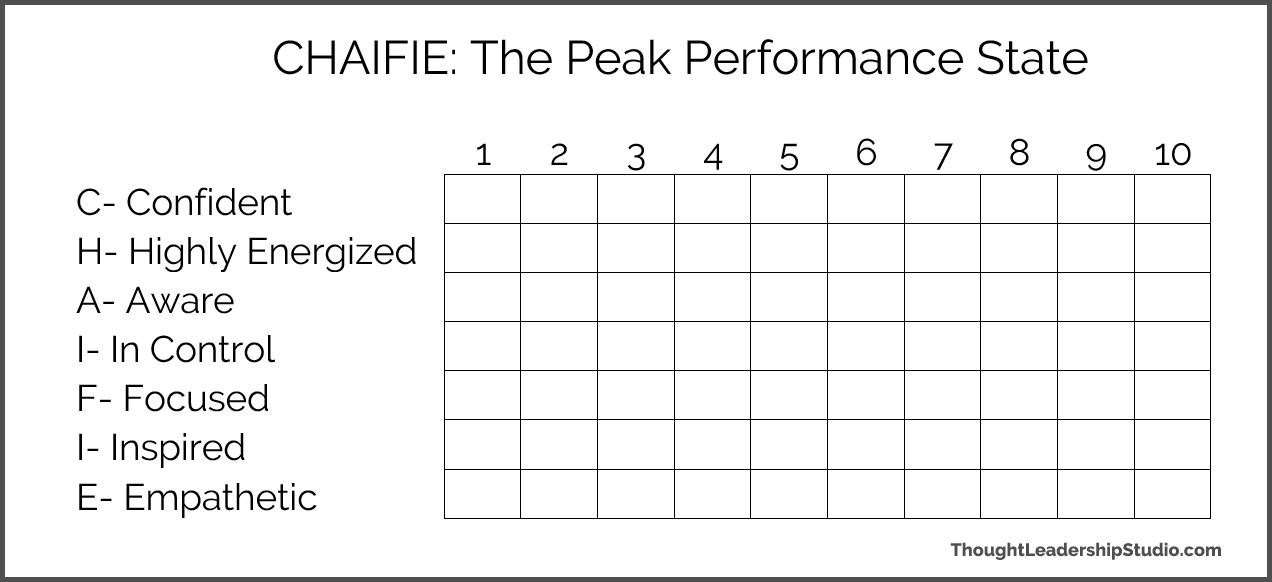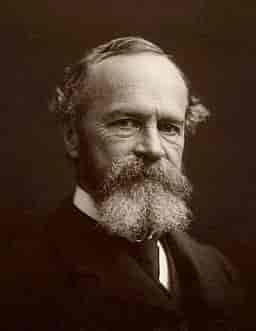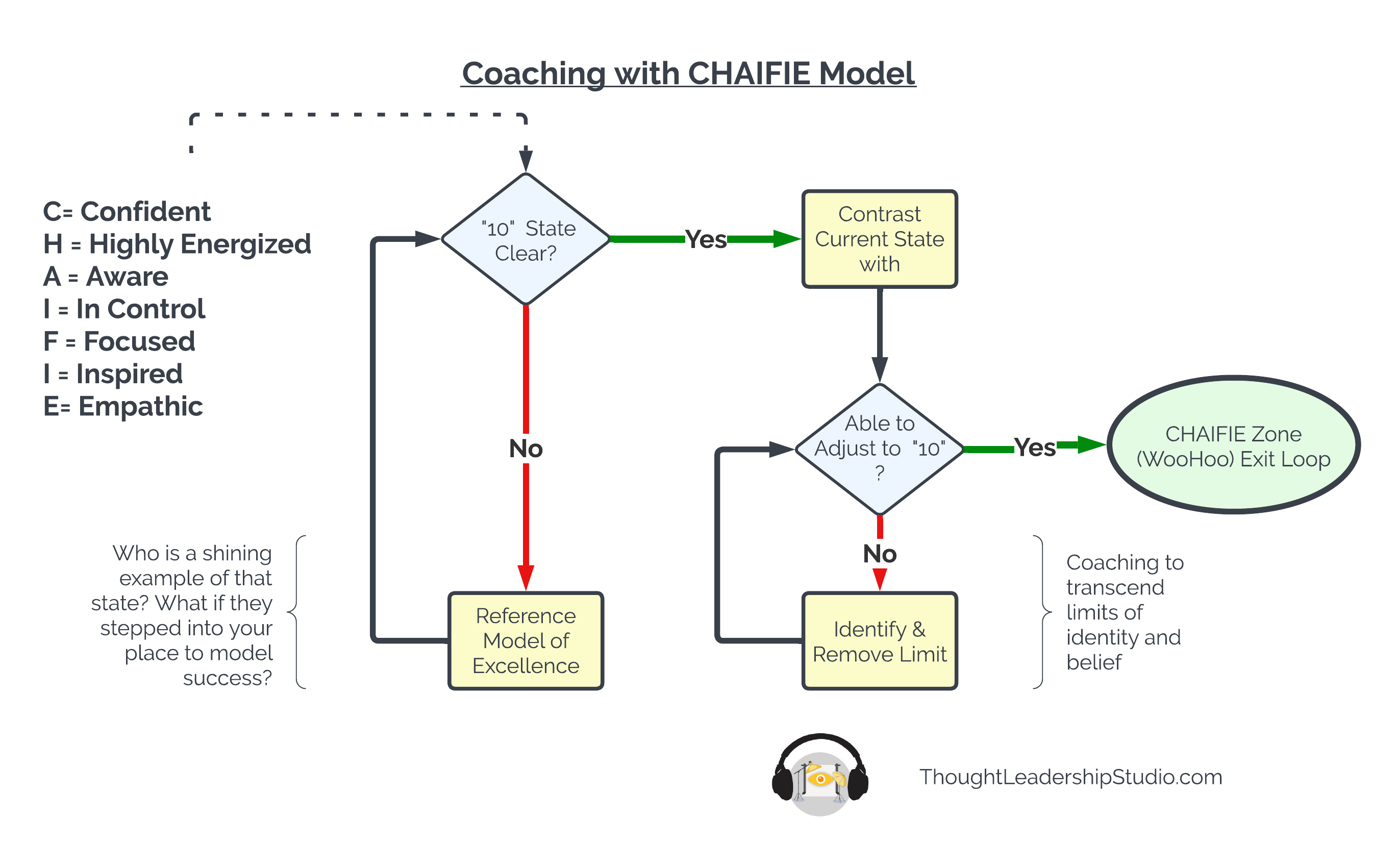Thought Leadership Studio Podcast Episodes:
The Seven Aspects of the Peak Performance State
Episode 24 - Attain and Apply the Ideal State for Strategic Thought Leadership and Other Areas of Performance with the CHAIFIE method

#coaching, #consulting, #creativity, #imagination, #inspiration, #inspiration, #leadership, #mentaltraining, #motivation, #neurolinguisticprogramming, #nlp, #persuasion, #strategicthoughtleadership, #thoughtexperiments, #thoughtleadership, #thoughtleadershipmodel, #workshop
Or Click here to listen or subscribe on appWhat this episode will do for you
- Define the ideal mental state for strategic thought leadership and other areas of high performance with the CHAIFIE model.
- Help you better recognize how attuned you are to that state.
- Teach you methods for accessing and amplifying that state.
- Help you discover how to connect that state to both your own performance and positively influencing your audience.
Defining the Peak Performance State
There is an optimum state of mind that is common to high performance in fields as loosely related as sports, business, science, mysticism, and the arts. Architects of human performance like Sports Psychologists and Neuro-Linguistic Programmers have studied the state and discovered it has definable characteristics.
In the podcast episode, I am going to describe the CHAIFIE state and give you methods for attuning to it, accessing it, amplifying it, and putting it where you want.
History- Evolution of the CHAIFIE Model
Part of what's got me interested in the mental side of performance was my involvement in athletics. I immersed in the field of sports psychology which led to me working with a sports psychologist who had worked with two United States Olympic teams.
I learned that the mental game in athletics was at least as important as the physical aspects. He used an Ericksonian hypnotherapy model so, since Milton Erickson was one of the major models of early Neuro-Linguistic Programming, this was also a perfect introduction to NLP, a field I would later get deeply immersed in and gain Master Practitioner status with.

The Mental Game Separates the Leaders
In sports, genetics are part of success. If you're three feet tall, you're not likely to succeed at basketball. But once you're in an approximate range of the right genetics for a particular sport, then it's the mental side that defines the elite performers.
It's the grace under pressure like Joe Montana exhibited in the cliffhanger 1988 Super Bowl when he brought his team from behind in the final moments while staying calm, cool, and collected.
It's the ability to draw upon reserves of focus, discipline and motivation and apply them towards step by step increases in performance, or in engineering breakthroughs by creatively designing out of the frame methods for going beyond what could be achieved within the prior frame of performance achievement.
Find the you who can be a peak performer.
- Dr Charles Garfield
So those are the two paths of performance enhancement: optimization and innovation, and you should use both.
I learned through luminaries like Dr. Charles Garfield, Richard Bandler and John Grinder, as I discovered that the field of Neuro-Linguistic Programming for me had even more promise than that of Sports Psychology. At the time, it seems Sports Psychology was the one branch of Psychology that focused on generative change: improving performance beyond the norm rather than remedial change of fixing problems.
And this episode is all about generative change by learning to elicit and apply the peak performance state of mind that is common to outstanding performance in the sciences, the arts, athletics, and business.
This powerful and transcendent state of mind has specific characteristics.
So we're going to:
- understand what this state of mind is,
- learn how to recognize it in yourself, and
- gain more conscious control over it so you can...
- put it where you want it.
One way to understand and better access it is to define its characteristics. The CHAIFIE model lists 7 of them, which are:
- Confident
- Highly Energized
- Aware
- In Control
- Focused
- Inspired
- Empathetic
Take the first letter of each and it spells CHAIFIE.

Let's zoom in on each of the seven characteristics.
Confident
The C in CHAIFIE stands for confidence: the sense that you have the ability to do whatever it is you need to do. Confidence implies you fully believe in your abilities. You know you can do it, whatever "it" is.
Highly Energized
The second is feeling highly energized towards the achievement of what you want physically, mentally, and emotionally. It is the experience of having more than enough energy at hand to take all the steps necessary to achieve your intention.
Aware
The third is awareness. This is might be best understood by its application in sports because the optimum size of your field of awareness is situation dependent.
Generally, it's about being fully immersed in the moment. It is being centered on the here and now- not thinking about what you're going to do after a performance or what you did before.
And then there's what some might call the cocoon of concentration, which applies especially to solo sports like long distance running where the runner will be intensely aware of their own physiology with a narrow, mostly internal field of awareness. But in team sports or business events like speaking to a large audience, you want to have a more broad, expanded field of awareness.
No matter the optimal size of the field of awareness for the context, In every case it is being aware acutely of the sensory experience of the here and now, mostly free from interference from the inner dialogue of the rational mind.
In Control
Then there is the sense of being in control; a sense of directing your mind and body to do specifically what you want them to at each point in time.
Working with an organization, feeling this sense of control with the organization is not so much about controlling other people, but controlling your response to other people. It also can include influencing the larger system of an organization or audience by using system dynamics to nudge it in the direction you want it to go.
Since you are part of the system, you can influence the system and feeling fully in control of yourself assists in that.
Focused
The next characteristic is being focused: rallying all of your your attention to fully center on your goal and which you are currently doing to achieve it.
This is the opposite of multitasking. It is a state of focused immersion- undistracted, a discipline that is extremely valuable in today's world of multiple ongoing distractions like with social media.
Inspired
The second eye ("i") of the seven point system is inspiration. Other attributes can be about getting in the right state to accomplish something predetermined. The state of inspiration includes the creativity to envision better futures than you might have thought of previously.
It can be likened to the state of the creative artist, a state of divine guidance, a state of having a higher purpose beyond yourself that draws you forward to making unique positive contributions that could only come from you.
Empathetic
And the last of the seven attributes is being empathetic. This is about being attuned to the response of others that you impact.
It is assisted by taking what we call "second position": seeing things from their eyes, feeling things from their position to include sensitivity to those you impact to better lead emotionally, mentally, and physically.
********
So just understanding what these aspects are is helpful. But then how to access this state more easily and apply it more effectively?
The starting point might be utilizing your own personal history of peak experiences: eliciting times when you felt each of these characteristics and stepping back fully into those times so you:
- see what you were seeing
- hear what your hearing and
- feel what you're feeling and then
- repeat for each of the seven attributes so you can...
- stack them all together so you get this fully empowered CHAIFIE state that includes all the seven attributes.
- Then while you hold this stacked state, think about the thought leadership you want to have,
- the positive impact you want to have, and
- the audience response you want.
... as you elicit this amplified stacked-state of the seven characteristics of peak performance for your thought leadership and its impact.
For recalling previous exemplary examples of each aspect of the CHAIFIE state, your external success is less relevant than how you felt. It's not about whether you took first or second place in a competition. It is about your internal feelings of confidence, focus, high energy, being in control, empathy, or inspiration.
This will help calibrate how you arrange the internal and external factors that lead to creating states of excellence so that you can more consistently get to those states. (See the pdf farther down)
A Real-Life Example: Performance State Tracking in a Fitness Training Context
 An internal self-assessment/ state management scale like CHAIFIE might have seemed unusual for personal training- a context where some peoples' expectation was simply directing a session, counting reps, and serving an accountability function.
An internal self-assessment/ state management scale like CHAIFIE might have seemed unusual for personal training- a context where some peoples' expectation was simply directing a session, counting reps, and serving an accountability function.
But I never saw things that way. Before the term "thought leadership" was prevalent, with my chain of 1-on-1 fitness studios, I like to think I was practicing thought leadership by reframing the role of the fitness trainer to be that of optimizing performance.
My trainers didn't just do this with nutrition and exercise, but also with enhancing mental performance with a system that drew from fields like NLP and Sports Psychology .
The time with clients was utilized to help them optimize their state, to increase their motivation, to increase their confidence, to increase their focus, and to maximize performance in the session.
In addition, it was about helping them future-pace the lifestyle changes between sessions that would further optimize performance. These included balancing rest and relaxation for full recovery as well as bringing in healthier eating habits.
The trainers' role included facilitating optimum mental performance as the greatest leverage point for optimizing physical performance.
And many of these practices became incorporated into performance enhancement software, both the Wireless Workout - which predated smartphones and used handheld many computers - and FitPoint, an online gamification of fitness to make tracking progress, visual and even more reinforcing.
The national innovation awards these apps won became stepping stones to moving into motivational and marketing software. I sold the training studios to friendly competition to give this opportunity my full focus.
Marketing, especially including Strategic Thought Leadership, is obviously also about motivation.
Through using Neuro-Linguistics to model the most successful market leaders and breakthrough campaigns over the years of running my digital agency, I discovered and organized the key factors structurally behind their success to develop the Thaut Process of Strategic Thought Leadership.
State Design is also just as important in market leadership as it is in high performance in other areas.
So, let's use CHAIFIE to do some state design.
 One way to use the scale is to rate yourself on the scale immediately following a performance such as a high-impact business meeting or recording a marketing video.
One way to use the scale is to rate yourself on the scale immediately following a performance such as a high-impact business meeting or recording a marketing video.
For each aspect, ask yourself, Where was I on a scale of one to 10? This will help you to gain more control so that you can direct it higher on scale intentionally. This brings up internal questions like I think I was at a "7". I wonder how things would be different if I was at an "8" next time?
This can cue internal imagery, like seeing yourself at a "10" for each aspect as a reference for rating yourself.
Back to the fitness training example.
This type of self-rating Q & A of mental state was part of the system in my fitness training studios and their accompanying software. At the end of every training session, the trainer asked the client to give a rating for "confidence", for "focus", for "high energy", and for "in control".
To answer, clients had to go inside and ask themselves where they were at. This meant they were imagining what a "10" would be like. This brought them gradually closer to it.
Self awareness = self regulation.
The trainers' interactions around the scale brought in an external feedback loop for noticing and directing motivation, focus, control, and energy.
Sure, there were an occasional person who complained it was a little "woo" to them. Once we stopped doing it as an experiment, The very next time a particular client came in, he said, "What happened to the scale? It helped me focus. I felt like I got more out of it."
So the scale came back and it stayed.
This system was based on the belief that motivation isn't something random but more like something you can control for optimum performance ... should you choose to do so by taking control of the internal and external factors that many leave to chance.
Some might leave their motivation largely to chance because they may not yet realize that - no matter how random our models of the world may be, how carelessly we've accumulated our identity and our beliefs about what the world is and how it works and who we are and what our roles are in it - these things structurally affect our experience of the world.
So it's worth taking the time to take control of our internal experience and the states it generates.
 And only when you take control and become the driver of the bus, so to speak, instead of the rider on the bus of your mind, can you intentionally start to tap into the deeper levels of what some have called hidden human reserves.
And only when you take control and become the driver of the bus, so to speak, instead of the rider on the bus of your mind, can you intentionally start to tap into the deeper levels of what some have called hidden human reserves.
I might ask a client, can you imagine how things would be different if you were at a 10 on all of those factors every day?
... If you had that state focused on achieving what you want and leading your audience to new thinking and resulting positive experiences so you transfer some of that state along to them?
Sales and persuasion are largely about emotional leadership. Have you ever seen a sales trainer, maybe at a bright, vivid seminar, as they moved the audience to positive feelings while saying "sales is about the transfer of positive emotions"?
No matter how strong your logical arguments, they won't persuade without the power of leading to better feelings.
People make decisions largely unconsciously and largely based on better feelings or the expectation of better feelings... they just need the logical component to support those emotion-based decisions.
Take more control of your feelings and watch your sales soar to new, higher levels.
Both the logical and emotional aspects are addressed by the building blocks of Strategic Thought Leadership. The model provides both a logical structure (that undermines old thinking and supports new thinking) and a state path from old feelings to new, better feelings.
And isn't the best intrinsic reward of leadership uplifting others as you enrich their lives?
Get to the state and aim it at positive impact on your audience.
So you can also use CHAIFIE for state design for your audience. Designing a state path for your audience to take them to the better feelings that accompany your Thought Leadership Model is part of the Building Blocks of Strategic Thought Leadership.

Every one is familiar with the phenomenon of feeling more or less alive on different days. Every one knows on any given day that there are energies slumbering in him which the incitements of that day do not call forth, but which he might display if these were greater.
-William James, The Energies of Men
Working with the CHAIFIE Model
I have found the CHAIFIE model to be helpful for working with both individuals in a coaching context and in leading groups such as facilitated Masterminds.
Some ways to use CHAIFIE:
- Use a 1-10 grid to track CHAIFIE factors as a self-assessment to gain awareness and control. (You can use the downloadable pdf below for this)
- Use the CHAIFIE model to assess prior peak experiences and contrast with more "normal" times to discover factors that are consistent in your peak experiences so as to better recreate them. (Ditto for the pdf)
- Add CHAIFIE to visualization so when you imagine your future, you imagine it as your peak performance self with the CHAIFIE factors turned up.
- Incorporate into coaching, NLP, and/or hypnosis to program the unconscious mind to automatically put the peak performance state where you want it.
- Auto-Suggestion- reiteration of the characteristics to remind yourself to attune to them.
- Adding CHAIFIE to Your "Internal Control Panel" as with Design Human Engineering.
Crossing State Lines
If you are driving through Virginia or Mississippi with a radar detector, you might want to remember they are illegal in those states. Different states have different rules. That is just as true with states of mind so you might want to make sure you are in the right state. State Control is a mental skill worth developing and practicing.
Here's a graphic with a couple of exercises on a PDF to maximize your benefit from this seven point method.
Free CHAIFIE State Training Exercises for Download and Sharing.
Read online or download
Wait, it can't be that easy!?
CHAIFIE is still a helpful model when it seems hard to get to as it sets a direction for coaching or consulting. Here's a TOTE (test-operate-test-exit) diagram for using CHAIFIE in coaching, such as I do with some of my NLP Coaching clients.

***************************************
Free Stuff and Offers Mentioned in Podcast
***************************************